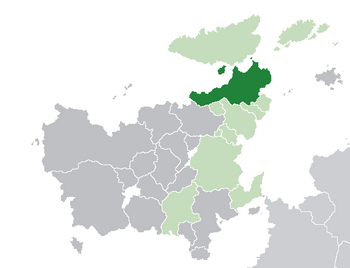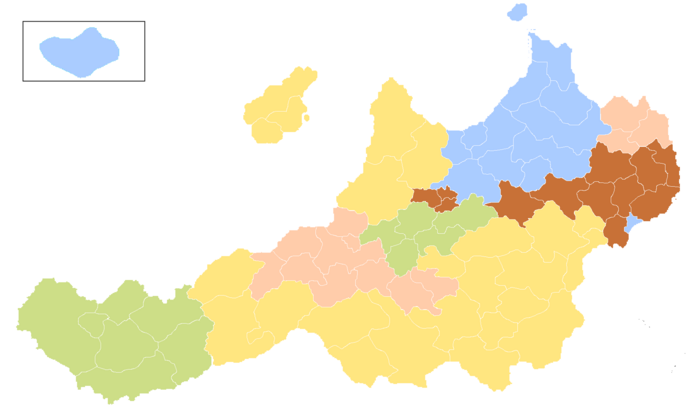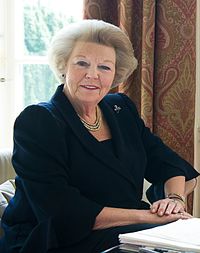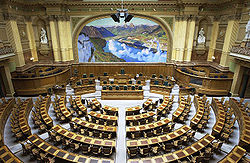Werania
This article is incomplete because it is pending further input from participants, or it is a work-in-progress by one author. Please comment on this article's talk page to share your input, comments and questions. Note: To contribute to this article, you may need to seek help from the author(s) of this page. |
Weranian Confederation Ostischer Bund | |
|---|---|
| Motto: Unteilbar und untrennbar Indivisible and Inseparable | |
| Anthem: Was ist des Ostischen Vaterland? What is the Weranic’s fatherland? | |
 | |
| Capital | Westbrücken |
| Largest city | Wiesstadt |
| Official languages | Weranian |
| Recognised regional languages | Ruttish |
| Ethnic groups | Weranic, Ruttish, Aldman |
| Demonym(s) | Weranian |
| Government | Federal parliamentary elective monarchy |
| Charlotte II | |
| Otto von Hößlin (NKP) | |
| Käthe Schickdanze (DA) | |
| Legislature | Bundestag |
| Herrstag | |
| Volkstag | |
| Formation | |
• Unification | 17 March 1842 |
• Ascension to the Euclean Community | 1955 |
| Population | |
• 2014 estimate | 58,579,684 |
| GDP (PPP) | estimate |
• Total | $2,767,931 million |
• Per capita | $44,231 |
| GDP (nominal) | estimate |
• Total | $2,631,134 million |
• Per capita | $42,045 |
| Gini | 28.0 low |
| HDI | 0.925 very high |
| Currency | Euclo (EUC (€)) |
| Date format | dd-mm-yyyy |
| Driving side | left |
| Calling code | +19 |
| Internet TLD | .we |
Werania (Weranian: Ostischland [ˈɔstɪʃˌlant]) officially the Weranian Confederation (Weranian: Ostischer Bund) is a constitutional monarchy and sovereign state in northern Euclea bordering Kirenia to the southwest, Estmere to the south, Borland and Azmara to the southeast and sharing a maritime border with Solstiana to the north. Its capital is Westbrücken and its largest city is Wiesstadt.
Weranian history dates back to the emergence of Weranic tribes during antiquity. The southern areas of Werania, Cislania, became part of the Solarian Empire before Weranic tribes drove the Solarians out by 311CE, resulting in the area to be split between various tribal entities. In 500CE the region became briefly under the authority of King Rudolf the Magnificent. Rudolf's empire splintered after his death, but in 574 CE the kingdoms under the authority of the Kingdom of Cislania formed the Rudolphine Confederation, a confederation of states wherein they remained independent but united under the authority of the elected Emperor of the Rudolphine Confederation. The Confederation would come to attempt to assert hegemony in the area, and as such faced numerous wars with its neighbours including Solstiana, Caldia and Kirenia.
The Confederation would see its constituent states come to conflict in the Amendist Wars with the spread of Amendism in the region leading to the confederation to weaken hugely at the expense of its neighbours, particularly Estmere and Kirenia. This was execerbated when the majority of the confederation fought in the losing side of the Ten Years' War. Bankruptcy, centralisation, feudalism, the unpopularity of Emperor Leopold III and the successful revolution in Etruria led to the Weranian Revolution which saw the Confederation dissolved, absolute monarchy repudiated and the Republic of Werania declared under the Declaration of Man and His Natural Rights. The republic was invaded by its neighbours and dissolved in 1801, being being divided into several kingdoms once again but left a potent legacy of pan-Weranicism.
During the 1800's the reformed Kingdom of Cislania through a series of conquests, royal marriages and diplomatic annexations was able to unify the disparate states. Under King Rudolf VI in 1842 the Weranian Confederation was proclaimed as a federal state. Werania would quickly industrialise and amass a colonial empire in Coius becoming a great power in the process especially after the War of the Triple Alliance. Werania's rise to great power meant during this period it had poor relations with its traditional rival Kirenia and their allies Gaullica and Narozalica, with Werania aligning increasingly more with Estmere and Etruria. Werania would as a result be heavily involved during the Great War against Gaullica, with the Weranian front being one of the bloodiest of the war famed for its heavy use of trench warfare. Following the war Werania was embroiled with a new rivalry with Kirenia due to anti-socialist sentiments which eventually led to the Kirenian-Weranian War which saw a defeat for Weranian forces. This spurred the decolonisation of the Weranian colonial empire and its entry into the Euclean Community, since retaining its position as one of the world's largest economies.
Werania is a liberal democracy, and has a mixed market economy based around finance, industry and agriculture. It also has a welfare state with subsidised healthcare and education. It is a prominent member of the Community of Nations, Euclean Community, Northern Forum and International Council for Democracy. It also is one of the few states to possess nuclear weapons.
Etymology
'Ōsaithaz = Our Oath (originally to an anti-Solarian character I think, I can't quite remember) Ostisch = Modern form of above Exonym origin: Gaullish: Tarchwéran Exonym – Werania Endonym – Ostischland'
History
Prehistory
Archaeological evidence dates human presence in Werania to at least 600,000 years ago, with the discovery of complete hunting javelins dating to 380,000 years ago in coal mines in Western Weranland. The Goel valley in Werania was the location where the first ever non-modern human fossil was discovered and recognised in 1856; the new species of human was named Goelerthal man.
Solarian Period
Solarian control of Werania was limited to territory south of the river Lahn, the territory there being referred to in historical documents as the province of Cislania. Around 260 SE, Eastern Weranic tribes started to break into Solarian territory, moving further south and west into Estmere, Vredlandian, and Weiderland, while areas of what is known today as western Werania were inhabited by various other Weranic people's such as the Ruttish.
While the Solarian Empire's collapsed allowed Gaullica and a number of other Euclean states to coalesce into kingdoms and petty monarchies, the province of Cislania proved to be an exception- the capital of Tecinum was sacked by Weranic tribesmen in 311 SE, and the provincial government was entirely dissolved, with the governor Publius Cisinus returning to Solaria in disgrace soon after.
Rudolphine Confederation
Middle Ages
Reformation
Pereramonic Wars
Republic
Modern history
Unification

The Great War
Post-Great War
Government and Politics
Werania has since unification in 1842 been a federal parliamentary de jure elective constitutional monarchy with an independent judiciary, a bicameral legislature known as the Bundestag (with an upper house known as the Herrstag and a lower house known as the Volkstag) and an executive known as the Cabinet. The head of state is the Federal Presidency (Präsidium des Bundes or Bundespräsidium). The Federal Presidency is held by one of the five constituent monarchs and is officially elected by the constituent monarchs after the death of abdication of the incumbent, making it a de facto monarchy. Up until 1986 the post was largely hereditary under the House of Schwarzollen-Brücken but after the 1986 Weranian constitutional crisis and the formulation of the Siegberg Convention the post officially rotates between the monarchs. The current holder of the Federal Presidency Charlotte II was the first head of state elected under this system in 1987 being co-currently the Queen of Roetenberg and the first Amendist monarch since 1705. The head of government is the Chancellor of Werania who heads the cabinet. The Bundestag has 232 members of the upper house and 545 in the lower house with the prime minister and cabinet governing with the confidence of the chamber. In practice the Volkstag is the more powerful house.
Werania’s political culture due to the legacy of deep political divisions during the 19th and 20th centuries has been marked by a sharp divide between the monarchist, Catholic right and the radical, socialist left. The Sotirian democratic National Consolidation Party (NKP) is considered the successor of the traditional Catholic right whilst the liberal Modern Centre Party (PMZ) is considered to be the party following the tradition of liberal reformists. The social democratic Social Democratic Radical Party of Werania (SRPO) is associated with the reformist-social democratic and radical tradition of the left whilst the Weranic Section of the Workers' Internationale (OSAI) - the oldest party in the country - is seen as representative of more revolutionary and radical socialism. Since the 1980's newer parties such as the environmentalist Green Party and souverainiste Democratic Alternative have emerged. Other parties are traditionally more ideologically narrow or represent regional-nationalist interests, such as the separatist National Coalition for Independence or völkisch Weranic Völkisch Freedom Party.
Since 2019 Werania has been ruled by a coalition government of the National Consolidation Party and the Democratic Alternative under Chancellor Otto von Hößlin.
Government
The executive government of Werania is the cabinet (bundeskabinett), which has 15 ministers including the Chancellor (bundeskanzler). The Chancellor is officially a primus inter pares acting more as the chairman of the government rather than head of government. Traditionally, executive decisions in Werania are driven by consensus. The cabinet relies on the confidence of the Volkstag in order to govern. Since 1979 all cabinets in Werania have been multi-party, giving Werania a tradition of coalition governments.
The current government is based on a coalition of the NKP and the DA, both of which represent the populist right of Weranian politics.
Legislature
Werania legislature is known as the Bundestag with an upper house known as the Herrstag and a lower house known as the Volkstag. The Herrstag's has 232 members with 116 seats elected every four years under a first-past-the-post system with Herrstag members serving eight-year terms. The directly elected Volkstag contains 545 members with 300 elected through proportioal representation and 245 through first-past-the-post. Sitting for a term of four years, the Volkstag officially lends support for the government, but since 1989 it can only dissolve the government it can swear in another government to fill out the previous one’s term — if this is not possible the monarch can appoint a caretaker cabinet to serve the rest of the Volkstag’s term.
There are ten parties currently sitting in the Volkstag. The governing parties are the conservative National Consolidation Party with 244 seats and the right-wing populist Democratic Alternative with 32 seats, holding an overall majority of 276 seats. The opposition is led by the centre-left Social Democratic Radical Party of Werania with 85 seats with the eco-socialist Green Party with 80 seats the third largest party in the Volkstag overall. Other opposition parties include the liberal Modern Centre Party with 32 seats, the Ruttish separatist National Coalition for Independence with 30 seats, the syndicalist Weranic Section of the Workers' International with 22 seats, the regionalist Sotirian Democratic Homeland, the völkisch Weranic Völkisch Freedom Party with 8 seats and the Aldman People's Party with 2 seats.
In 2018 the government passed a new electoral law that enforces a mixed-member majoritarian system with 300 seats in single-member districts and 245 proportional seats with no electoral threshold. The system is set to be in force for the 2023 elections.
Administrative divisions
Werania is divided into two kingdoms (Königreich), two free states (Freistaat; laisva valstybe), a grand duchy (Großherzogtum) three duchies (Herzogtum) and two free cities (freie stadt). The free cities are officially headed by Lord Mayors (Oberbürgermeister) who also serve as head of government, whilst the free states are technically headed by their legislatures. Aside the free cities each division are led by head of government known as a minister-presidents (Ministerpräsident) who are appointed by the monarch within the territory. Since the 1900's minister-presidents govern with the confidence of directly elected state diets (Landtag; seimas). As with the Volkstag local government's cannot be dismissed unless landtags or the seimas can propose an alternative government; if no alternate government is produced the Ministry of Regional Development can appoint a caretaker cabinet to serve out the reminder of the council's term.

Foreign Affairs
Armed forces and intelligence
The Reichswehr (Realm Defence) serves as the national defence force of Werania, being split between the army (Ostische Landstreitkräfte), navy (Marine von Ostischland), air force (Ostische Luftwaffe) and the military constabulary (Ostische Militärpolizei), a gendarmerie force that is under the authority of the Ministry of Defence.
The monarch serves as the commander-in-chief of the armed forces whilst the Cabinet via the Ministry of Defence oversees the chiefs-of-staff and manages the army as a whole. As of 2017, there are 365,835 active soldiers and 52,680 in reserve with Werania spending 2.4% of GDP on defence and the minimum age of recruitment being 18. Werania's armed forces are one of the largest in Euclea. Werania is a recognised nuclear power, maintaining an arsenal of around 180 active nuclear weapons that can be deployed by both air and sea based means.
Werania's foreign policy since the end of the Great War has meant its military has undergone strategic and personnel changes. The Weranian constitution defines Weranian security protocols as being based on the principle of collective security with the army being tasked with protecting the people of Werania and ensuring peace in Euclea. Conscription for all adult males was previously in force until 1996 when it was abolished, with the armed forces being a fully professional army since. Werania maintains a large weapons and aerospace industries.
The main intelligence service of Werania is the General Intelligence Organisation (Allgemeiner Nachrichtendienst; AND) which falls under the authority of the Ministry of Home Affairs. AND handled both domestic and foreign intelligence operations, with the two function being merged in 1973. The Military Intelligence Organisation (Militärischer Nachrichtendienst; MND) handles military intelligence matters being under the authority of the Ministry of Defence.
Geography
Biodiversity
Climate
Economy
Werania possesses a social market economy with partial regulations, low trade barriers and an extensive welfare state. Werania has a GDP PPP of $2,767,931 million and a nominal GDP of $2,631,134 million, making it the third largest economy in Euclea after Gaullica and Estmere. The Ministry of Finance (Finanzministerium) is responsible for setting government expenditure and implementing government financial policy, whilst the Zentralbank acts as the central bank within the Euclozone banking system, with Werania using the Euclo as the national currency formally using the Reichsmark.
Services make up two-thirds of the economy of which finance is the major component, with Werania and its largest city Wiesstadt is considered to be the main financial centre of Euclea. Werania's diversified economy also is notable for its pharmaceutical, arms, aerospace infrastructure and automotive industries. Werania's economy also has basis in agriculture, transportation, telecommunication services and tourism. The primary agricultural exports in Werania are maize, sunflowers, barley, sugar beets and wheat. The Weranian government has majority shares in the railway, electricity, aircraft, nuclear power and telecommunications, albeit since the 1990's it has started to corpratise or partially privatise these industries.
During the 1940's the Weranian government managed the economy through Keynesian means, with a strong focus on manufacturing leading Werania into quadrupling its economic growth between 1930-1964. During the 1980's the economy was deregulated with most state run industries privatised, with free trade and deregulation being championed. The government cut corporation tax leading to many companies to move to Werania; investment in science and technology increased substantially as the government sought to make Werania into a technology hub. Werania had a real estate bubble that existed from 1994 (when the capital gains tax was cut from 42.5% to 18.6%) to 2005 when the bubble collapsed leading to Werania to enter recession - the economy remained in recession until 2012 when growth returned.
Agriculture
Banking
Currency
Industry
Services
Energy
Transportation
Demographics
Education
Ethnic groups
Healthcare
Werania, alongside the majority of the developed countries, maintains a two-tier system of universal healthcare, divided between a statutory health insurance system centred around the Health Assistance Programme (Program zur Gesundheitshilfe; PzGH) and a private sector. There also a large alternative medicine sector controversially subject to lax regulation.
The PzGH was created in 1986 by merging and restructuring health coverage schemes across Weranic states. Prior to 1986 healthcare coverage was at the discretion of state governments albeit an ordinance from 1957 committed state governments to providing some form of universally-available healthcare. The PzGH works as a single-payer compulsory social insurance plan. Citizens can opt to be covered by the PzGH's insurance plans with the use of a PzGH card which entitles them to access to PzGH services, meaning those who do not possess PzGH cards cannot use PzGH services. The PzGH is financed through premiums based on the payroll tax and is supplemented with out-of-pocket payments and direct government funding. Provision of healthcare however depends on state governments - the Ruttish government for example owns and employs much of the hospital staff in the state whilst in Cislania most hospitals are privately owned with the government contracting their services for patients covered under the PzGH. Unless signed onto a private insurance scheme coverage by the PzGH is compulsory for Weranic citizens. The PzGH only does partial coverage of dental and optic treatment, not covering cosmetic services.
A smaller private sector within the healthcare industry exists for those who wish to pay for private services. Private health providers are also arranged around insurance schemes, which pay for healthcare providers either within state-owned facilities or private hospitals.
The alternative medicine industry in Werania is considered to be controversial due to relatively lax regulation. In 1921 the government passed laws consolidating the role of heilpraktiker's which gave way to a large naturopathic industry with homeopathy being a particularly important component. Alternative clinics often mix legitimate medicinal practice with alternative methods and have been known to offer an unproven but legitimate experimental drugs in their treatment. Many of these clinics have been accused of offering patients expensive but ineffective treatment for conditions such as cancer leading to some of accuse them of health fraud with some states restricting the registration and operation of heilpraktikers.
Life expectancy in Werania is high, with women on average living for 83.8 years and men 78.4, ranking overall at around 81.1. Cancer, alcoholism and obesity are considered the mot pressing issues in relations to Weranian health, with the government heavily advocating weight loss camps. Since the mid-1980's, smoking has been on the decline in Werania.
Language
Largest cities
Religion
Culture
Art
Cuisine
Bottom row: Spätzle with fried beef and onions and a šakotis spit cake.
Weranian cuisine has been shaped by its position in northeast Euclea, sharing similarity with Kirenia and Estmere. Werania's climate means that the country exhibits strong regional divergences in its cuisine; notably Cislania's warmer climate enables it to grow a much wider variety of foodstuffs and keep larger herds of livestock.
Since the 1950's mass production of meat has led to meat consumption in the country to dramatically increase, with pork, poultry and beef being the most consumed meats in that order. Some of the main foodstuffs grown in Werania include barley, potatoes, rye, beets, greens, berries, and mushrooms. Horseradish and mustard are popular condiments in Werania, whose food as a general rule tends not to use many spices. Sauerkraut is a well-known ingredient in Weranian cuisine.
The main regional cuisines in Werania are Cislanian (including Wiesstadan), Brücken, Bonnlitzer, Roetenberger and Ruttish cuisine. All the Weranian regional cuisines tend to have continuity between them in the heavy use of rye, potatoes and pork and veal as part of many dishes.
Werania is home to some famous dishes. The most famous is schnitzel which is meat (usually veal) butterflied and covered in breadcrumbs; it is alleged to have been taken from a similar Vespasian dish but no conclusive link has been proven. Sausages tend to be a staple food in Werania; the main kind are bratwurst which are made from pork or veal and seasoned with ginger, nutmeg, coriander, or caraway. Spätzle is considered to have been a traditional working-class dish being a form of pasta cooked with eggs. Didžkukuliai dumplings made from potatoes and filled with either cheese, ground meat or mushrooms and šakotis spit cake are considered to be the most famous Ruttish dishes.
During the 19th century both Weranian and Ruttish cuisine was heavily inspired by Gaullican haute cuisine which has led to many dishes to change to fit such tastes over time. Nevertheless Weranian cuisine was less affected by foreign influences until the post-war period when immigration from southern Euclea, Asteria and Coius led to a surge of new cuisines to take root in Werania. Vespasian food became the first widely available non-north Euclea food in Werania; Kuthinian and Senrian cuisine were some of the earliest non-Euclean cuisine to become popular in Werania in the 1960's which would be later followed by Maririanan, Xiaodongese, Taboran and Tsabaran food.
Werania is well known for its beer industry (considered to be one of the oldest in Euclea) with the highest beer consumption in the world (131.4 litres per year by consumption per capita in 2019). Beer is often made according to the "purity code" that stipulates that only water, hops, and malt can be used as ingredients and that beers not exclusively using barley-malt such as wheat beer must be top-fermented. Although the purity code is not official law it is widely adhered to in Werania. Weißbier and Märzen are considered to be the traditional beers of Werania whilst Schafner is the most popular beer accounting for half of total beer sales. Werania has the most beer breweries in the world. Beer culture in Werania is tied to volksfests which combines a beer festival with a traveling carnival, beer halls and beer gardens. Ruttland also shares the rest of Werania's high beer consumption, but has a more farmhouse brewing tradition and does not share the same cultural acitivties and venues for drinking.
Weranian wines that are mass produced are mostly dry white wines, with sweeter ones often being counted amongst some of the most high-quality in northern Euclea but having far smaller production. Midus is a Ruttish-produced mead popular in the province.





















